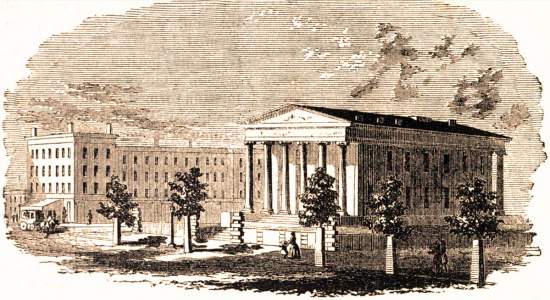Dayton, Ohio (Hayward)
Gazetteer/Almanac
Dayton, O. City and seat of justice of Montgomery co. On the Great Miami River, at the mouth of Mad River, 50 miles N. from Cincinnati, and 68 W. by S. from Columbus. The Miami Canal from Cincinnati to Lake Erie passes through this place. Population in 1810, 383; 1820,1139; 1830,2954; 1840, 6067; 1850, 10,996. Dayton is one of the largest places in the interior of the state. There is a large water power within its corporate limits, and a still greater within the immediate vicinity. The principal manufactories in operation here are cotton and woollen factories, flouring mills, saw mills, oil mills, paper mills, iron founderies, and machine shops, and shops for the manufacture of clocks, scythes, gun barrels, flooring machines, &c. The amount of capital invested in these various operations is large. By the assessment of 1846, Dayton was the second city in the state in the amount of taxable property. Its progress was very gradual from its settlement in 1796 to 1812, when the war with Great Britain, making it a thoroughfare for troops and military stores on their way to the frontier, gave a great impulse to its prosperity. The construction of the Miami Canal has secured to it, of late years, a rapid and healthful increase.
The court house in Dayton is the most costly and elegant in Ohio, being constructed of cut stone, upon a beautiful Grecian model, surmounted by a handsome cupola. It cost between $60,000 and $70,000. The other public buildings are a jail, of stone, a city hall, two academies, several banks, and a number of church edifices, which are elegant specimens of architecture. Many of the private residences are tasteful, and beautifully situated. The Cooper Female Academy has a spacious edifice, three stories high, for its accommodation. There are nine turnpike roads centring at Dayton, and connecting it with different parts of the country.
The court house in Dayton is the most costly and elegant in Ohio, being constructed of cut stone, upon a beautiful Grecian model, surmounted by a handsome cupola. It cost between $60,000 and $70,000. The other public buildings are a jail, of stone, a city hall, two academies, several banks, and a number of church edifices, which are elegant specimens of architecture. Many of the private residences are tasteful, and beautifully situated. The Cooper Female Academy has a spacious edifice, three stories high, for its accommodation. There are nine turnpike roads centring at Dayton, and connecting it with different parts of the country.
John Hayward, Gazetteer of the United States of America.... (Philadelphia: James L. Gihon, 1854), 346.



